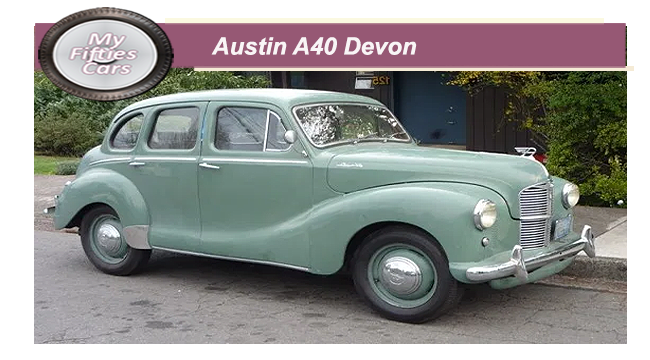
The A40 Devon and its two-door counterpart the A40 Dorset were the first post-war saloons to be released by Austin, making their debut at the Paris Motor Show of October 1947.
The Austin Devon, Dorset and the Countryman Estate that was released soon after are recognized as being the company’s first cars specially projected with mass production and export appeal in mind.
 Developed and produced in a post-war era of shortages, and lack of technical development, this unlikely trio were technically a genuine “hotchpotch” of new and old-fashioned features.
Developed and produced in a post-war era of shortages, and lack of technical development, this unlikely trio were technically a genuine “hotchpotch” of new and old-fashioned features.
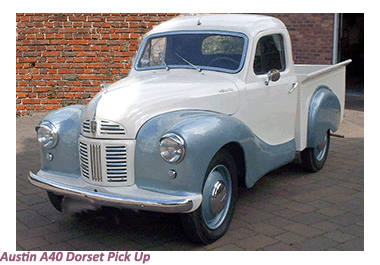 The motoring press were not slow to express their dissatisfaction at the car's stance, which they were quick to point out smacked too much of the pre-war era, although, despite the media's misgivings, it soon emerged that Austin had found a winner.
The motoring press were not slow to express their dissatisfaction at the car's stance, which they were quick to point out smacked too much of the pre-war era, although, despite the media's misgivings, it soon emerged that Austin had found a winner.
During its production run, more than 450,000 Devons were sold, before the model was discontinued five years later in 1952, replaced by the Austin A40 Somerset.
 Austin had begun to grasp by the early Fifties that while having a four-door sedan in the range was almost a must; the two-door was not such a good idea with the Dorset lagging way behind in sales to the Devon.
Austin had begun to grasp by the early Fifties that while having a four-door sedan in the range was almost a must; the two-door was not such a good idea with the Dorset lagging way behind in sales to the Devon.
Some of the company’s disappointment must have been offset by the tremendous sales performance that the Countryman Estate car put in, with the panel van and pickup trucks also faring very well.
![]()
Once again. the point was proved that despite being slightly conservative in design, that shortcoming could be made up by being a highly practical workhorse.
T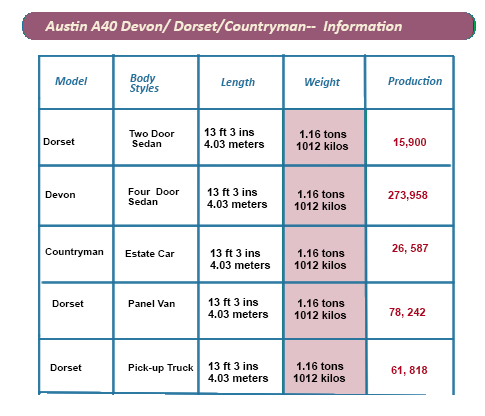 he cars’ overhead-valve engine was all-new (it was the forerunner of the legendary B-Series which followed), as were the car's coil spring independent front suspension.
he cars’ overhead-valve engine was all-new (it was the forerunner of the legendary B-Series which followed), as were the car's coil spring independent front suspension.
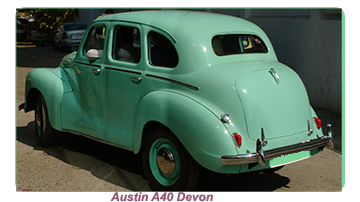 A useful feature of this bodywork was the rear-hinged deep-sided bonnet which gave excellent side access for routine maintenance. At the rear was a rather small luggage boot, this did however have the benefit of a drop-down lid with hinges sufficiently strong to allow the lid to be used as a platform in exceptional circumstances.
A useful feature of this bodywork was the rear-hinged deep-sided bonnet which gave excellent side access for routine maintenance. At the rear was a rather small luggage boot, this did however have the benefit of a drop-down lid with hinges sufficiently strong to allow the lid to be used as a platform in exceptional circumstances.
Another space-saving innovation was that the spare wheel was housed in the luggage compartment beneath a false floor.
 The Austin Devon/ Dorset/Countryman combination’s interior was finished to quite high standards for what was a relatively inexpensive car.
The Austin Devon/ Dorset/Countryman combination’s interior was finished to quite high standards for what was a relatively inexpensive car.
Standard equipment included window winding mechanism in the doors, with the addition of swivelling quarter windows for 1950, twin sun visors, comprehensive instrumentation, and a sprung three-spoke steering wheel.
A steel sliding sunroof was available at extra cost, as was a heater unit.
Despite their compact dimensions, the A40 Devon/ Dorset/Countryman were quite heavy, weighing in at just over a ton.
![]()
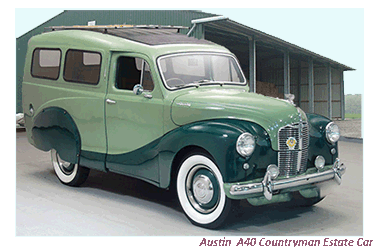
Nevertheless, the 1200cc engine would accelerate the car to 60mph (100 kph) in around 45 seconds, and on to a maximum of more than 65mph (108kph) - if conditions were favourable.
The Devon/ Dorset/Countryman combination went on to become a significant commercial success, not only in the UK but throughout the British Empire with Longbridge churning out 2000 models every week to keep pace with the demand.
 Until overtaken by the A30/A35, and later by the Mini, no other Austin had ever sold so well globally, showing that the A40 Devon was an ideal vehicle for those looking for a reliable workhorse during the early Fifties.
Until overtaken by the A30/A35, and later by the Mini, no other Austin had ever sold so well globally, showing that the A40 Devon was an ideal vehicle for those looking for a reliable workhorse during the early Fifties.
The four-door A40 Devon and to a lesser degree, the two-door Dorset were particularly well received in the United States, even becoming Britain's biggest dollar earner till the launch of the Mini more than ten years later.


